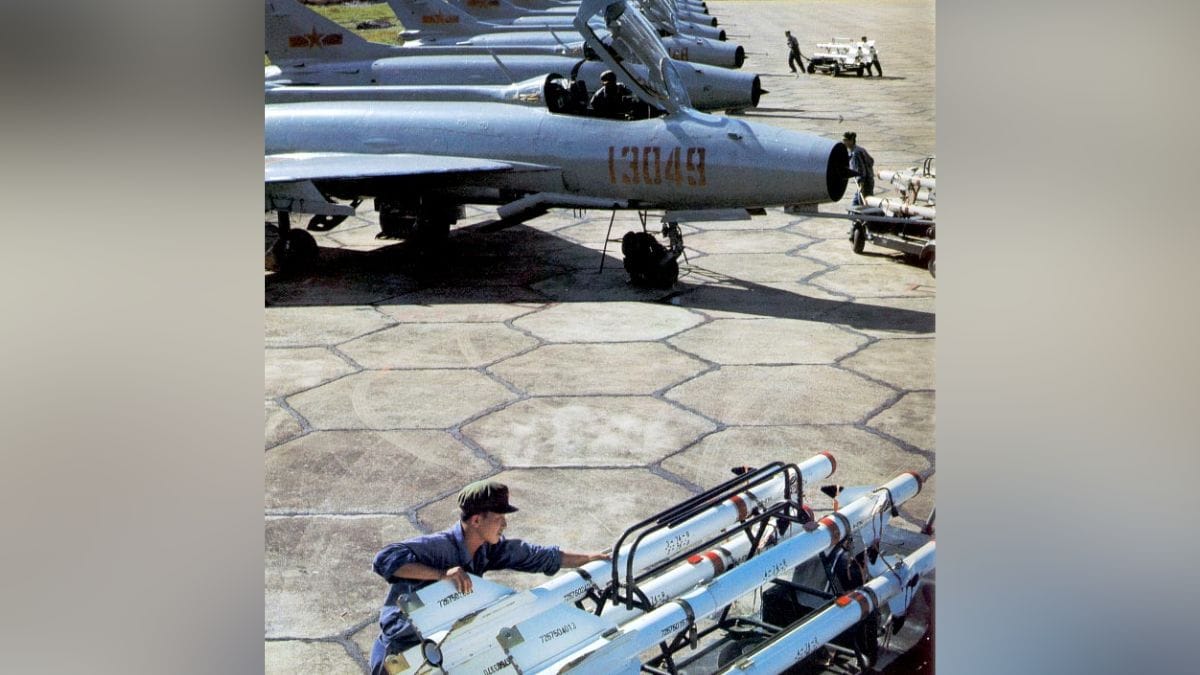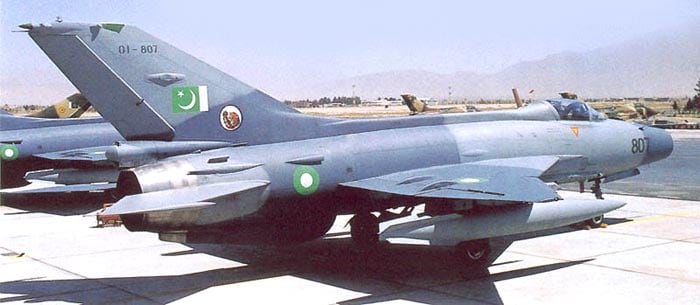J-7 Fighter Jet - A Reverse-Engineered MiG-21 But With A Chinese Touch
The aircraft, often referred to as 'Grandpa Fighter Jet', was developed in the 1960s by China, initially in partnership with the Soviet Union, but later, when Sino-Soviet relations soured, Beijing reverse-engineered the MiG-21.

A China-built F-7 fighter jet, operated by the Bangladesh Air Force, crashed into a college building in Dhaka, killing 19 people - The pilot, 16 students and two teachers. The aircraft, often referred to as 'Grandpa Fighter Jet', was developed in the 1960s by China, initially in partnership with the Soviet Union, but later, when Sino-Soviet relations soured, Beijing reverse-engineered the MiG-21 and built J-7 or F-7 (the export variant).
Bangladesh, Pakistan, Iran, Myanmar, Namibia, Nigeria, North Korea, Sri Lanka, Sudan, Tanzania and Zimbabwe operate the aircraft, which was designed from the mighty MiG-21F-13 variant. Bangladesh has 36 F-7 aircraft, which is the export variant of J-7. Meanwhile, Pakistan is the biggest operator of F-17 with at least 120 aircraft. Most of the aircraft in China's inventory are copies of American and Russian-made fighter jets.
Read more: 16 Students, 2 Teachers, Pilot Killed As Jet Crashes Into College In Dhaka
Produced Under Agreement Or Reverse Engineered?
In 1961, China's Mao and the Soviet Union's Nikita Krushchev signed an agreement to produce the MiG-21 in China under a licence. The MiG-21, along with some technical documents, were sent to the Shenyang factory in August 1962, but the deteriorating ties between the two powers led to a lapse in the agreement, and China went ahead without Soviet assistance.

MiG-21 is the world's most mass-produced fighter jet. At one point, it was one of India's leading fighter jets.
The technical documents, according to China, were incomplete; however, the Soviets denied the charge. The engineers at Shenyang began to reverse engineer the MiG-21F-13 variant of the Soviets and ended up identifying and solving 249 problems in the aircraft, and made at least eight technical documents for the aircraft. In 1964, the Shenyang Aircraft Corporation began the production of the first aircraft named J-7I, which looked almost the same as the MiG-21, which has a swept delta wing design and an air inlet in the nose. But internally, the two varied.
MiG-21 was designed around a simple airframe. It was inexpensive and went supersonic. The objective in designing the aircraft was for point defence with its air-to-ground attack capabilities. The Chinese wanted to follow the Soviets and suited the PLA's strategy - Having a large number of fighters to challenge the West, especially around Taiwan, their Achilles Heel.
China Brings Its Changes
The Chinese did not copy-paste MiG-21 but made certain changes that impacted the J-7's aerodynamics. They identified an issue with the hydraulic system of the MiG, because of which 70% of the aircraft were grounded in squadrons, and the location of the fuel tanks, which caused instability.
However, it was China's most mass-produced aircraft with several operators in the Middle East, Asia and Africa. It was the backbone of the PLA Air Force at one stage. The mass production of J-7 helped China develop and manufacture aircraft at fast pace to outnumber the US.

The first J-7 variant - J-7I was very similar to the MiG-21F-13 version.
Credit: airforceworld.com
The MiG-21 carried most of its fuel in the forward fuselage, and after a flight of about 45 minutes, the aircraft was unstable. The Chinese repositioned the fuel tanks in J-7, and added larger drop tanks to provide longitudinal static stability - A jet's tendency to return to its original pitching altitude after it is moved up and down.
However, the 1960s were one of the most tumultuous periods for China. Mao's policies, like the 'Great Leap Forward' and the 'Cultural Revolution', not only impacted industrial growth and manufacturing in the country but also caused famines because of directives like collectivisation of farming etc. The Chinese managed to mass-produce J-7 only in the 1980s under Deng Xiaoping.
The first J-7 variant - J-7I was very similar to the MiG-21F-13 version. The Chinese used the WP-7 engine, which was similar to the Russian R-11 Turbojet. The J-7 had a 30mm cannon, just like the Russian NR-30, and it had a PL-2 Air-to-Air Missile (AAM), similar to the Russian AA-2. But it had complications in its ejection seat.
The 1980s for J-7
The Chinese developed the J-7II variant later, with improved ejection seat and better engine - WP-7B. Almost 20 years had passed since the inception of the aircraft, and the 1980s saw significant improvements in the jet. The later variants were equipped with the WP-13 engines.
In the mid-1980s, Pakistan requested a J-7 variant with greater radar capability. Both the standard Chinese radar and the British Marconi radar were plagued by ground clutter, and China lacked experience with air-to-ground radar. In 1984, Pakistan provided support by assigning American-trained F-16 pilots to train Chinese personnel on ground attack radar usage. This led to the development of the J-7M, aviation website AirVectors said in a report.

Pakistan is the largest operator of the J-7 fighter jets. The Pakistan Air Force helped improve the aircraft's radar.
Credit: airforceworld.com
The Chengdu Aircraft Corporation (CAC) designed a zero-zero ejection seat - A seat that can eject even on the ground. It was better than the KM-1 ejection seat the Soviets used during that time. However, the Chinese ejection seat, HTY-5, for J-7 or F-7 was similar to Martin Barker's ejection seat on the J-7M variant, which was even exported to Bangladesh
MiG-21 had a forward-opening, forward jettison canopy upon ejection. The Chinese repositioned it for J-7 and used a rear-hinged, upward jettison canopy. The J-7 only matched its Soviet MiG-21 capabilities by the mid-1980s.
In 1987, J-7E became the first MiG-21 variant to include a helmet-mounted sight, HOTAS (Hands On Throttle-And-Stick), and a multi-purpose display. Many of these components were British-made, such as the gun sight and display.
Further improvements turned the aircraft into a fourth-generation short-range interceptor. The Chinese stopped production of the aircraft in 2013, but it still has many operators.
MiG-21 is infamously called the "Flying Coffin" because of its flight safety record, but the two aircraft have a varied crash history. The MiG-21 was developed in 1955 and has undergone several changes, but its production stopped several years ago, and scarcity of parts often posed challenges in maintaining the aircraft.
The Indian Air Force inducted MiG-21 in 1963, and it still has two squadrons that operate the aircraft; however, they will be phased by most likely by the end of this year with the induction of the Tejas aircraft.
-
Opinion | Navigating the Tightrope: Why Putin's Visit Is A Masterclass In India's Foreign Policy
India's engagement with Russia is not without risks. Its decision to host the summit, nonetheless, and continue its trade ties despite overt disapproval from the West, is a clear exercise of strategic autonomy.
-
Opinion | Putin In India: Why A Fuming Europe Must Accept Its Problems Aren't Of India's Making
The initiative of the three European envoys to write an article in an Indian daily maligning Putin and Russia just before the Russian president's visit served no real purpose. It was diplomatically unwarranted.
-
Opinion | The Anti-Putin 'Op-ed': Why Europe Must Stop Lecturing India Like It's 1905
Europe has had it easy for centuries. Today, two non-European powers - the US and Russia - are deciding its fate. What really stings the old continent today is this acute feeling of impotency, a sense of irrelevance.
-
Opinion | India Still Needs Something Like Sanchar Saathi - Just Not Like This
India is experiencing what authorities describe as a "peak menace" of digital fraud. The Supreme Court recently took suo motu cognisance of digital arrest scams after victims collectively lost approximately Rs 3,000 crore.
-
Opinion | Sanchar Saathi Mess: 5 Lessons From The Centre's Spectacular Misfire
It's worrying that nobody in authority had the brains to anticipate the outrage that has dominated the public discourse in the last two days. In a way, the government has brought this blowback upon itself.
-
Opinion | Guns To Rallies, How 'Drug Money' Is Fuelling Khalistani Extremism In Canada
Since 2007, more than 200 gang-related homicides in British Columbia alone have been linked to rival Punjabi-Canadian gangs fighting for control of the lucrative cross-border drug trade
-
Opinion | Scindia's Ghost Is Haunting Congress Again - This Time In Karnataka
As Deputy Chief Minister DK Shivakumar stakes his claim to the top post, the party's high command is walking a tightrope, acutely aware that one misstep could lead to a repeat of the catastrophic loss it suffered in Madhya Pradesh in 2020.
-
Opinion | Dharmendra: The 'Pehelwan' Who Was A Poet
Dharmendra described himself as a 'mitti ka beta' (son of the soil). But some of his most memorable roles were those of a man of words, a teacher or a poet.
-
Opinion | The Imran Khan I Know - By Shashi Tharoor
"I have known Imran Khan in three distinct phases of his life. Our first meeting was in New York, during my UN years. His sister, a UN colleague, hosted a gathering, and Imran, then a cricket celebrity, was present. I was struck by his warmth."
-
Opinion | Why A US Report Mentioning 'Pak Success' Has India Bristling
Just one sentence in a report of a US Congressional Commission has got a lot of knickers in a twist in India. The sentence in the 675-page report reads: "Pakistan's military success over India in its four-day clash showcased Chinese weaponry."
-
News Updates
-
Featured
-
More Links
-
Follow Us On










